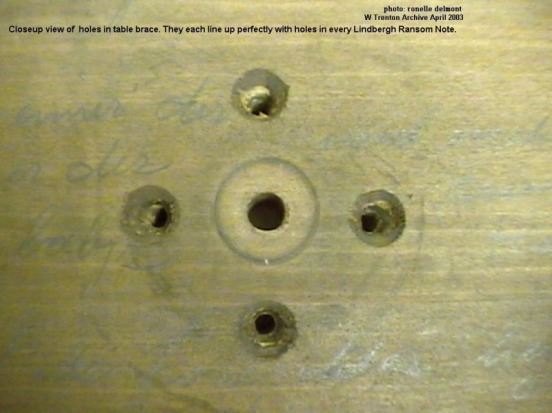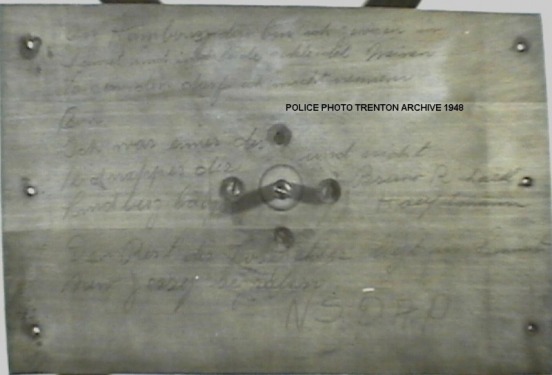Signature Symbol
The note, penciled in German on the table, has been translated as saying, "I was one of the kidnappers of the Lindbergh baby and not Bruno Richard Hauptmann." It also said that some of the ransom money had been buried in Summit.
See article below for further information.
"This Case Never Closes"
By BECKY BATCHA
Published: June 29, 2003
THERE is nothing like a newly rediscovered piece of evidence from the Lindbergh kidnapping to inflame the passions of crime buffs. And the latest find - retrieved from an old crate stored in a warehouse at State Police headquarters in West Trenton - is a humdinger.
Rummaging through the contents of the long-ignored crate, which included shoes and other ephemera from the 1935 Lindbergh trial, a State Police archivist, Mark Falzini, found a wooden board bearing a handwritten, anonymous note confessing to the taking of the infant son of the hero aviator Charles A. Lindbergh.
The note, penciled in German, has been translated as saying, "I was one of the kidnappers of the Lindbergh baby and not Bruno Richard Hauptmann." It also said that some of the ransom money had been buried in Summit.
Hauptmann, of course, was the illegal German immigrant who was convicted of felony murder for the 1932 slaying of 20-month-old Charles A. Lindbergh Jr., who had been abducted from the nursery window of the Lindbergh country house near Hopewell. Hauptmann, maintaining his innocence to the end, died in the electric chair.
That a statement taking responsibility for the kidnapping has emerged from someone other than Hauptmann is not in itself remarkable.
"We have a filing cabinet full of letters that people wrote saying, 'I'm the kidnapper"' and asking for the ransom money, said Mr. Falzini, who oversees the vast Lindbergh kidnapping archive owned by the State Police. He is also aware of 16 people who have claimed to be Lindbergh's kidnapped son, now grown, including an African-American woman from Trenton.
But Mr. Falzini says this particular confession appears to be genuine. A series of holes in the board lines up precisely with in the original Lindbergh ransom notes. The coincidence suggests that the board is the template that was used to puncture the three-hole pattern that the police in the Lindbergh investigation came to recognize as the kidnapper's signature. "The ransom holes line up perfectly," Mr. Falzini said. "It doesn't look like it's a hoax."
Lloyd Gardner, a Rutgers history professor, who has written a book on the Lindbergh trial for Rutgers University Press that is due out next spring, confirmed that the holes in the board and the ransom notes matched with uncanny precision.
"It's stunning," he said. "I would say that there's very strong evidence that this is the template."
Less evident is how the confession ought to be interpreted. Mr. Falzini said the handwriting did not match Hauptmann's, which suggests either that the convicted killer had an accomplice or that he was perhaps innocent, even though about $15,000 of the $50,000 in ransom money was foundn his garage.
A vexing detail is that the note is signed "N.S.D.A.P." - the German initials for the Nazi Party. The Nazi connection is so out of context with the body of Lindbergh trial evidence that neither Mr. Falzini nor Mr. Gardner knows what to make of it.
"That's the kind of evidence this is," Mr. Gardner said. "It's mysterious, it's challenging, and no one can explain it. Thank heavens the police didn't just throw the board away. It's rather remarkable that it survived."
Mr. Falzini is not the first to have seen the German words written on the board. Newspaper clippings from 1948 indicate that the State Police were called to investigate writing on a piece of wood found braced to the underside of a table owned by a South Plainfield man. The authorities of the day dismissed the finding as a hoax, apparently without taking notice of the holes.
That is where things stood until Mr. Falzini, getting to a task that had long been on his to-do list, unlocked the crate in the police warehouse last November. The board's significance became apparent when he retrieved the first of the Lindbergh ransom notes from a safe, placed it atop the board and found the holes to be in alignment. In January the discovery attracted the attention of a television news crew from Orlando, Fla., that had come to New Jersey to investigate another angle of the Lindbergh case. The news spread to Lindbergh hobbyists worldwide this spring when Mr. Falzini alerted several scholarly researchers like Mr. Gardner and a trio of lively Lindbergh Internet forums.
Michael Melsky, a federal prison counselor and Lindbergh trial hobbyist who oversees one of the Internet sites, quickly drove from his home in Bucks County, Pa., to the New Jersey State Police Museum, a building on the West Trenton campus that houses the Lindbergh archives.
"I went down there and saw it right away -- within a week," he said.
On March 4, Mr. Melsky posted this message: "I am convinced we have the 'template' for the holes . Mark made the discovery of a lifetime."
Mr. Kazman said Mr. Falzini's recent discovery was welcome news. "What it does is to perpetuate the lore and the myth surrounding the case," he said. "It continues to perpetuate the controversy."
New York Times
By BECKY BATCHA
Published: June 29, 2003
THERE is nothing like a newly rediscovered piece of evidence from the Lindbergh kidnapping to inflame the passions of crime buffs. And the latest find - retrieved from an old crate stored in a warehouse at State Police headquarters in West Trenton - is a humdinger.
Rummaging through the contents of the long-ignored crate, which included shoes and other ephemera from the 1935 Lindbergh trial, a State Police archivist, Mark Falzini, found a wooden board bearing a handwritten, anonymous note confessing to the taking of the infant son of the hero aviator Charles A. Lindbergh.
The note, penciled in German, has been translated as saying, "I was one of the kidnappers of the Lindbergh baby and not Bruno Richard Hauptmann." It also said that some of the ransom money had been buried in Summit.
Hauptmann, of course, was the illegal German immigrant who was convicted of felony murder for the 1932 slaying of 20-month-old Charles A. Lindbergh Jr., who had been abducted from the nursery window of the Lindbergh country house near Hopewell. Hauptmann, maintaining his innocence to the end, died in the electric chair.
That a statement taking responsibility for the kidnapping has emerged from someone other than Hauptmann is not in itself remarkable.
"We have a filing cabinet full of letters that people wrote saying, 'I'm the kidnapper"' and asking for the ransom money, said Mr. Falzini, who oversees the vast Lindbergh kidnapping archive owned by the State Police. He is also aware of 16 people who have claimed to be Lindbergh's kidnapped son, now grown, including an African-American woman from Trenton.
But Mr. Falzini says this particular confession appears to be genuine. A series of holes in the board lines up precisely with in the original Lindbergh ransom notes. The coincidence suggests that the board is the template that was used to puncture the three-hole pattern that the police in the Lindbergh investigation came to recognize as the kidnapper's signature. "The ransom holes line up perfectly," Mr. Falzini said. "It doesn't look like it's a hoax."
Lloyd Gardner, a Rutgers history professor, who has written a book on the Lindbergh trial for Rutgers University Press that is due out next spring, confirmed that the holes in the board and the ransom notes matched with uncanny precision.
"It's stunning," he said. "I would say that there's very strong evidence that this is the template."
Less evident is how the confession ought to be interpreted. Mr. Falzini said the handwriting did not match Hauptmann's, which suggests either that the convicted killer had an accomplice or that he was perhaps innocent, even though about $15,000 of the $50,000 in ransom money was foundn his garage.
A vexing detail is that the note is signed "N.S.D.A.P." - the German initials for the Nazi Party. The Nazi connection is so out of context with the body of Lindbergh trial evidence that neither Mr. Falzini nor Mr. Gardner knows what to make of it.
"That's the kind of evidence this is," Mr. Gardner said. "It's mysterious, it's challenging, and no one can explain it. Thank heavens the police didn't just throw the board away. It's rather remarkable that it survived."
Mr. Falzini is not the first to have seen the German words written on the board. Newspaper clippings from 1948 indicate that the State Police were called to investigate writing on a piece of wood found braced to the underside of a table owned by a South Plainfield man. The authorities of the day dismissed the finding as a hoax, apparently without taking notice of the holes.
That is where things stood until Mr. Falzini, getting to a task that had long been on his to-do list, unlocked the crate in the police warehouse last November. The board's significance became apparent when he retrieved the first of the Lindbergh ransom notes from a safe, placed it atop the board and found the holes to be in alignment. In January the discovery attracted the attention of a television news crew from Orlando, Fla., that had come to New Jersey to investigate another angle of the Lindbergh case. The news spread to Lindbergh hobbyists worldwide this spring when Mr. Falzini alerted several scholarly researchers like Mr. Gardner and a trio of lively Lindbergh Internet forums.
Michael Melsky, a federal prison counselor and Lindbergh trial hobbyist who oversees one of the Internet sites, quickly drove from his home in Bucks County, Pa., to the New Jersey State Police Museum, a building on the West Trenton campus that houses the Lindbergh archives.
"I went down there and saw it right away -- within a week," he said.
On March 4, Mr. Melsky posted this message: "I am convinced we have the 'template' for the holes . Mark made the discovery of a lifetime."
Mr. Kazman said Mr. Falzini's recent discovery was welcome news. "What it does is to perpetuate the lore and the myth surrounding the case," he said. "It continues to perpetuate the controversy."
New York Times




